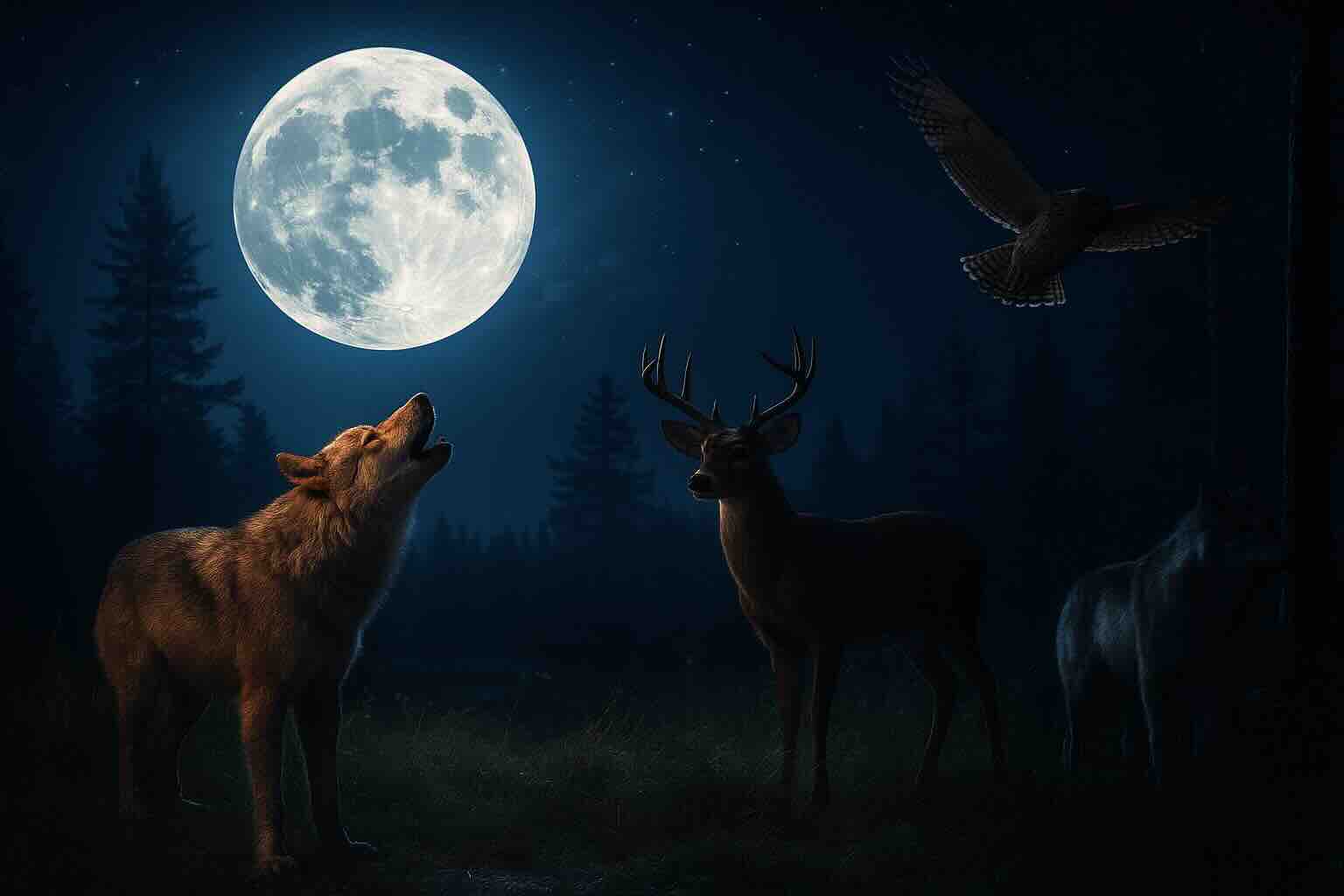For thousands of years, people have noticed how animals seem to move with the moon. From the chorus of frogs under a full moon to sea turtles crawling ashore, lunar cycles quietly guide life on Earth. Today, science is beginning to confirm what folklore long suggested: the moon is more than a light in the night sky — it is a biological clock for countless species.
The Moon as a Natural Calendar
The moon’s steady phases offer a reliable clock for animals. Unlike sunlight, which changes daily, moonlight follows a predictable 29.5-day rhythm. This makes it an ideal signal for reproduction, migration, and feeding. For species that live by cycles, the moon becomes a guide as important as the rising and setting sun.
Some animals rely on this lunar calendar to synchronize group behaviors. For example, many marine creatures spawn during specific phases of the moon, ensuring survival by overwhelming predators with sheer numbers of offspring.
Sea Turtles and the Light of the Moon
Few stories illustrate the moon’s role better than the journey of sea turtles. For millions of years, hatchling turtles have emerged from sandy nests under the cover of darkness. Guided by the faint glow of the moon reflecting on the ocean, they crawl toward the waves.
Artificial lights from cities now confuse them, pulling them inland instead of toward safety. Conservationists often speak of this as proof of the moon’s crucial role. A single lunar glow, once reliable, now faces competition from human-made light pollution — a modern challenge to an ancient survival instinct.
Coral Reefs and Lunar Spawning
Every year, coral reefs perform a breathtaking ritual timed to the moon. During specific nights after a full moon, corals release billions of eggs and sperm into the ocean. This synchronized event, called mass spawning, ensures that fertilization occurs across vast reef systems.
The timing is so precise that scientists can predict it down to the night, all thanks to lunar cycles. Without the moon’s rhythm, reefs would struggle to reproduce effectively, threatening one of the most diverse ecosystems on the planet.
Nocturnal Hunters and Moonlight
Not all animals use the moon as a romantic calendar. For predators like lions, wolves, and owls, moonlight can be an advantage or a disadvantage. Bright nights allow hunters to see prey more easily, but prey species also become more alert, reducing hunting success.
Studies show that some carnivores adjust their hunting strategies with lunar phases. Wolves, for example, tend to move more during darker nights, while certain big cats may take advantage of full moons to patrol their territory.
Insects and Lunar Guidance
Moths, fireflies, and other nocturnal insects often navigate using moonlight. They maintain a steady angle relative to the moon to fly in a straight line. But under artificial lights, this navigation system fails, causing insects to spiral endlessly around lamps — a phenomenon known as phototaxis.
Once again, the moon demonstrates its ancient role as a guide, one that human development has unintentionally disrupted.
Fish, Frogs, and Breeding Rhythms
Many fish and amphibians breed in harmony with the moon. For instance, some reef fish spawn during full moons when tides are strongest, carrying eggs far and wide. Frogs often call louder and gather in larger numbers under moonlit skies, turning wetlands into a symphony of sound.
This coordination ensures that mating success peaks when environmental conditions are most favorable, another example of how the moon subtly shapes survival strategies.
Bird Migration and Lunar Cues
Even birds are not immune to lunar influence. Some species migrate at night and appear to use moonlight for orientation. The brightness of the moon may help them stay on course during long journeys. Scientists have observed that cloud cover or lunar absence sometimes alters migration patterns, highlighting just how connected these creatures are to lunar cycles.
Humans and the Lunar Connection
While much of the research focuses on animals, humans have long wondered whether the moon affects behavior too. Folklore links full moons with sleepless nights, increased activity, and even mood swings. Scientific studies are mixed, but some evidence suggests that human sleep cycles may be slightly influenced by lunar phases.
Whether real or imagined, our cultural stories about the moon show how deeply it resonates with us — just as it does with animals across the globe.
Conservation in the Age of Light
The moon’s influence on animal life is undeniable, but its natural guidance system faces modern threats. Artificial lighting, urban sprawl, and climate change are altering the cues that species have followed for millennia. From turtle hatchlings heading the wrong way to coral reefs disrupted by warming seas, these challenges remind us of how delicate lunar-linked systems can be.
Protecting dark skies and understanding lunar cycles are now part of conservation strategies. By restoring the natural rhythm of moonlight, humans can help animals continue their ancient dances with the moon.
Conclusion: A Silent Guide in the Sky
The moon does not roar like a lion or sing like a bird, but its presence is written into the lives of countless species. It guides migrations, feeds ecosystems, and lights the path for survival under night skies. Whether through science or folklore, the message is the same: without the moon, life on Earth would be profoundly different.
As we learn more about these lunar mysteries, we are reminded that our planet is not isolated. Every cycle, every tide, and every creature is part of a cosmic rhythm — one in which the moon is a constant, silent guide.
